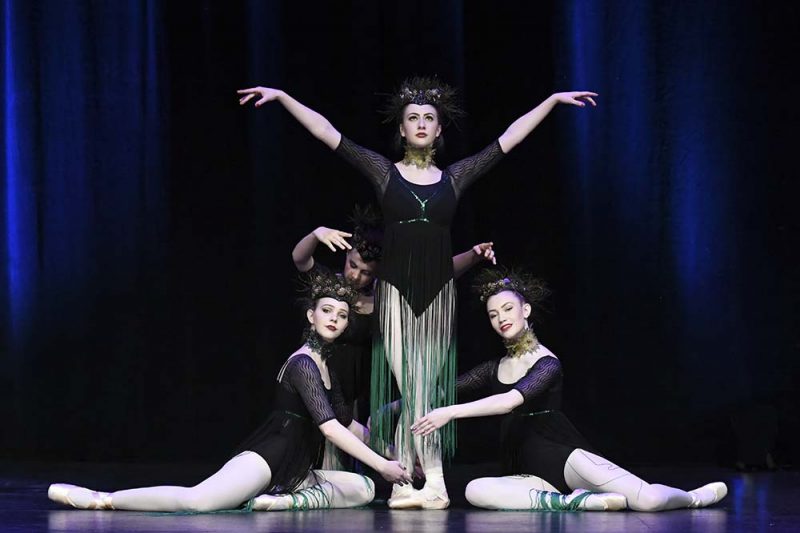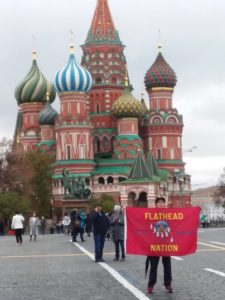
Rocky Mountain Ballet Theatre brought its Engelmann Spruce Tree dance to Russian audiences.
By Juliette Crump, University of Montana Professor Emeritus of Dance

Did you know the Kremlin Museum is almost a mile long? And whoa! You should see Catherine the Great’s wedding dress!
In October I was fortunate to go on the road with Rocky Mountain Ballet Theater to Tatarstan, The Russian Republic and Moscow, as a former RMBT board member and UM Professor Emeritus of Dance. The RMBT Company received a grant from the U.S. State Department for this tour.
I watched my granddaughter, Ruby Jenni, perform RMBT choreography with six other dancers. Five other people – director Charlene Campbell Carey, associate director Karen Careno, company manager Jennifer Kerber, singer Leslie Stevens and RMBT Historian Laurie Horowitz – participated with the dance group at the First International Contest Festival Named after Alfia Avzalova.
Rounding out the RMBT company were Kasper, a hip-hop dancer originally from Los Angeles, and Louis Plant, a Salish fancy dancer from Arlee, who brought styles of dance not seen live before in Kazan.
The first day allowed a few minutes onstage for each group and then a showing took place of all the festival dances and singing, lasting from late morning to late night. Our dancers were first to perform six pieces, which had been previously performed in a tour to China in September.
This time in Kazan there was no warm-up. The dancers just blasted on stage performing all six pieces one after another. The Engelman Spruce Tree dance had been on point when it was performed in Washington, DC, last November, but the floor wasn’t quite right for point this time, nor was it quite wide enough for all of Kasper’s back flips.
The dancers looked very American among the folk-style Tatar dances. We were guests at the festival, and joined the others who had come to show their best work.
Six Tatar girls made a strong impression in their white swan costumes, the wings extending far above their heads, using arms, fingers and knuckles for the swans head and beak.
The many folk dances were also beautifully costumed, some couples engaging in comic pantomime while other large groups with complex heel-toe patterns made energetic, flowing circles. I enjoyed seeing the round faces of the dancers, reflecting their Tatar ethnic background, originating in Mongolia, home of Ghengis Khan.
Tatarstan is 50% Tatar and 50% Russian and is known for its acceptance and pride in its ethnic differences. Tatarstan is very emphatic about preserving its culture and language and RMBT was invited to show aspects of Montana culture in dance performance. From hip-hop to contemporary dance, from dancers “en pointe” to Native American fancy dancing, RMBT conveyed choreographic images of Montana.
In the evening we were invited by Ravil Nigmedzyanov, one of the directors of the festival, to see a new piece of contemporary choreography by Nurbek Battullin, a medal-winning young Kazan dancer at the TAT CULT LAB/TEATP (a Tatar Community Center). His work focused on the Tatar alphabet and how it needs to stay in the Tatar culture, separate from Russian language and influence.
The dance started with a man reading a poem in Tatar and dancers came out speaking more words, men sometimes separating from the women and then coming together in a circle. The voice work was powerful and deep, the mood going from distraught to joyful, enhanced by the extreme lighting, backdrops and live music onstage.
A day later in the final festival gala performance, Kasper (America) and Nurbek (Kazan) performed a duet that they had worked up together using improvisation, and setting it into a combination of hip-hop and acrobatics. It was quite pleasing to the audience for its sharing aspect: Kazan ballet meets L.A. hip-hop.
Another collaboration evolved on site between RMBT and Kazan. Leslie Stevens, former Broadway dancer/singer, and Zarina Vildanya, a very well-known pop singer from Kazan sang a traditional Kazan song. Leslie was happy to work with a talented singer who spoke English. The majority of performers we met did not.

The gala performance had many exceptional singers with balalikas, accordions, drums and oboes live on stage. Backdrops were elaborate, showing the region’s environmental and cultural artifacts. The main visual projection was a spinning icon of the festival brand in Russian, Tatar and English.
As I watched, I was reminded of teaching dance history classes at UM where we studied those touring dancers from the early 20th century who took their innovative choreography abroad. Dancers Loie Fuller, Ruth St. Denis and Anna Pavlova – some of whom came through Montana – carried their trunks filled with tutus, leotards and designed costumes to demonstrate new perspectives on dance to foreign audiences. This time Louis Plant, Salish dancer, came with RMBT to Kazan with full regalia in his big suitcase, feathers, cloth, deerskin, rattles and fans.
Watching the Kazan dances I saw some stylistic comparisons to American clogging, country western dancing and Chinese singing but was drawn particularly to a young singer who won second prize in the contest, Isman Mirada. I wished I could have walked out with his professional CD, but he was only a student. His song was similar to the songs made famous by Alfia Avzalova, but his voice, unlike a female vocalist, was throaty, deep and strong in feeling.
Though the audience was more subdued and reticent than our American audiences, everyone stayed for the entire gala performance. At the end each group was called up and received a diploma for participation in the festival and we were saluted as we left the theater in the way the Russians often do to Americans, “Bye Bye.”
We left Kazan and headed to Moscow where we visited St. Basil’s Cathedral, the Kremlin and the Gum shopping district. I was able to buy a ticket for Ruby to the Bolshoi Ballet to watch a sold out “Spartacus.” She went with Kasper and they toured the famous theater, even danced some sections of “Spartacus” that they remembered later in the street. Ruby’s 15th birthday was coming up in two days. I had given her a gift that would last: dance memories from Russia.
Juliette Crump, Professor Emeritus of Dance at the University of Montana, is the former department chair and has a long and prestigious background in dance.